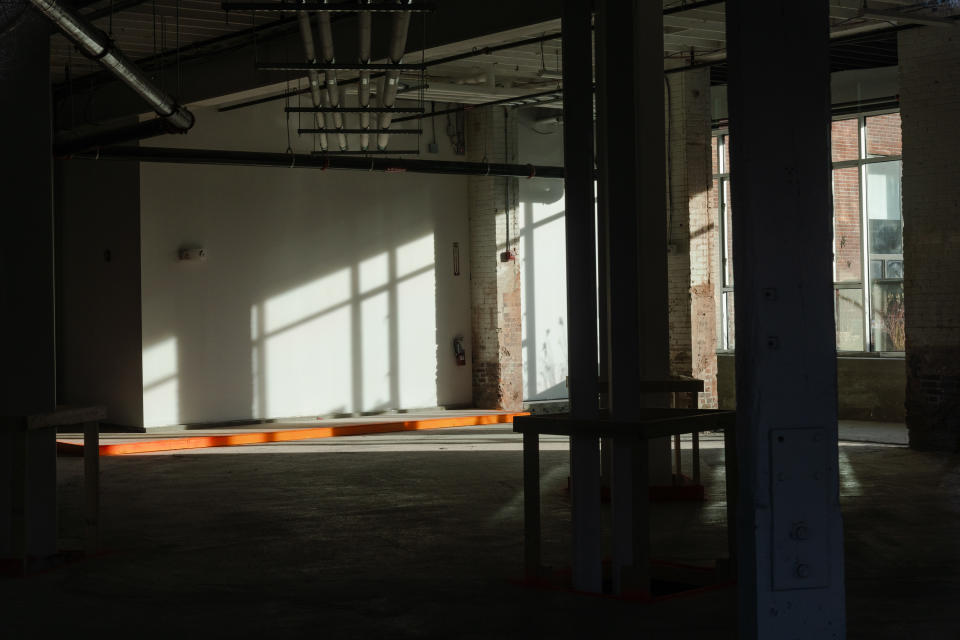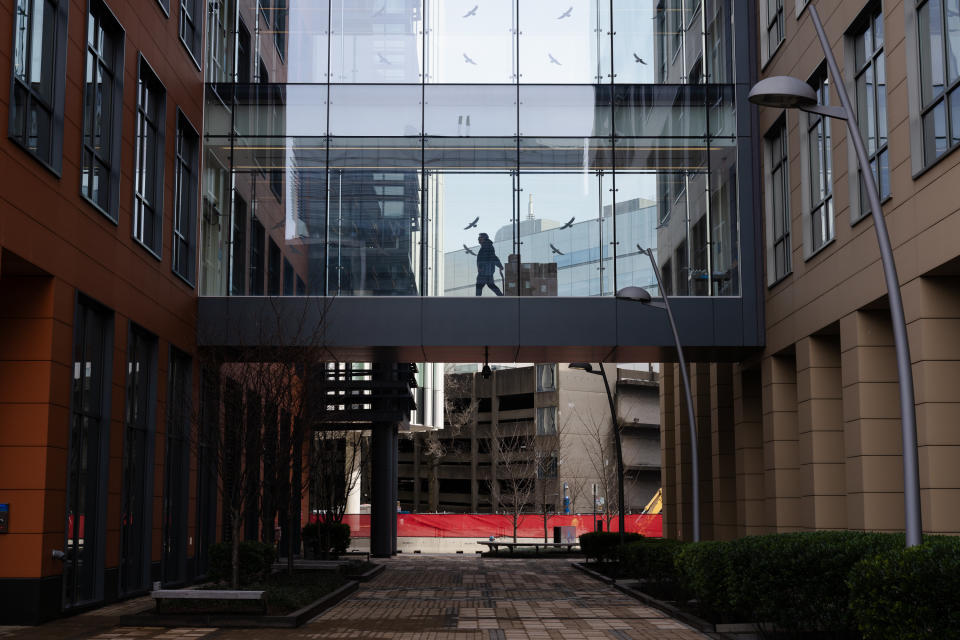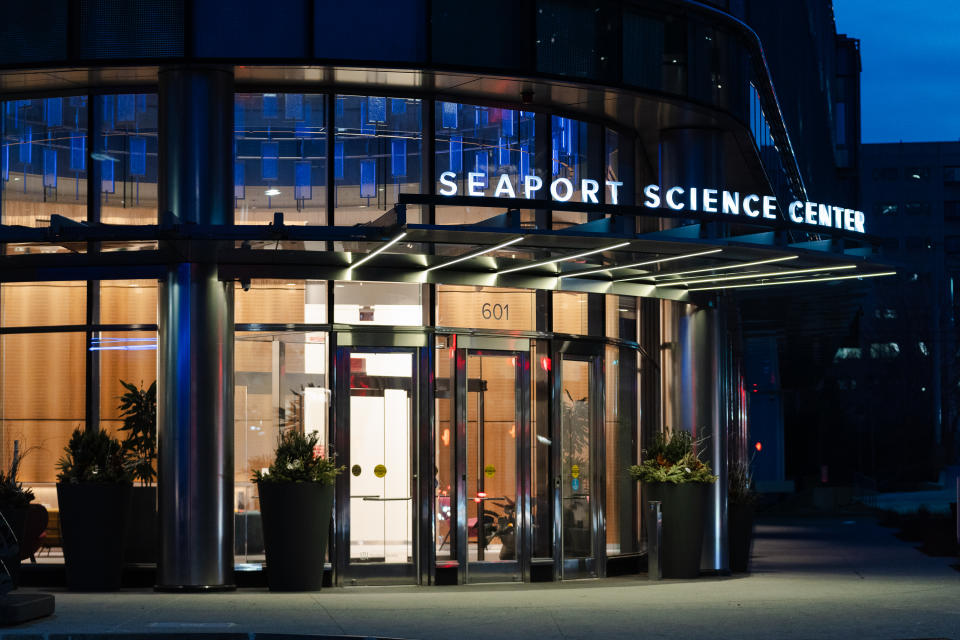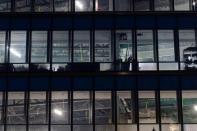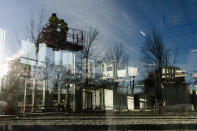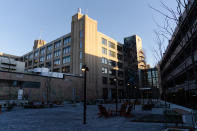Lab spaces boomed during the pandemic. Then the experiment took a turn.
CAMBRIDGE, Mass. - In the heart of the country’s No. 1 hub for science research sit roughly 100,000 square feet of gleaming new lab and office space. A banner declares the site at One Canal is smack “in the epicenter of the world’s most impactful discoveries.”
This kind of prime real estate would typically get scooped up. But there isn’t much discovery - or, really, much of anything - happening inside. A chain-link fence blocks the entrance from a quiet side street. And the site is almost entirely empty.
Similar scenes are cropping up all over Cambridge and neighboring Boston, where a massive influx of new lab space has scrambled the commercial real estate market. Of the 6.7 million square feet that finished construction last year, 62 percent is empty, according to data from the commercial real estate firm Cushman & Wakefield. Another 8.1 million is still under construction - largely without tenants lined up.
All across the country, cities are in limbo. Places like Austin, New York and San Francisco have their own excess office space. Economists are wary of a “doom loop” phenomenon that could turn empty downtowns into bigger economic hazards. Financial regulators are keeping a close eye on midsize banks that shoulder the bulk of commercial real estate loans, fearful of a wave of defaults.
The Boston area is unlike other places with too much office space and too few tenants: the causes are different, and the problem doesn’t appear to pose as much of a threat to the region’s broader fortunes.
But what’s happening is still another example of how the U.S. economy has repeatedly zigged when just about everyone thought it would zag. Decisions made in real time ultimately miss the mark. Data shifts before anyone has a chance to catch up.
Speaking to 60 Minutes earlier this month, Fed Chair Jerome H. Powell put the challenge looming over the entire economy this way: “What we thought we were learning two years ago, we would look back and say - completely different now.”
Starting in 2020, the pandemic prompted enormous interest from investors in health sciences. Around Boston, venture capital firms looking to fund the next lucrative disease treatment or prescription drug helped drive a boom in new lab construction. But starting in 2022, interest rates soared as the Federal Reserve tried to fight runaway inflation. High rates and the prospect of a recession meant investors could find easier places to park their money for a good return - and much less risk than venture capital offered. With the economy looking shaky, VC firms started pulling back, both out of skittishness and because they simply had less money to dole out.
Cash quickly dried up for life sciences start-ups. And that left an exceedingly small pool of companies that were growing enough to even entertain leases averaging $1,000 per square foot.
“Boston is a deeply paradoxical environment,” said Travis McCready, head of life sciences markets in the Americas for JLL, a commercial real estate advisory. “On the one hand, we are the most over our skis of any other major market in the United States. But on the other side, what is the reason you still see cranes in the air? The value proposition for Boston remains.”
No one expects the unleased lab space to derail the region’s reputation. Major pharmaceutical companies - Moderna, Biogen and Vertex - have their headquarters in the area, and universities like Harvard and MIT bolster the science sector even more. Plenty of local officials say Cambridge and Boston are weathering a real estate dip that will right itself in a few years.
“There will be room, there will be need, for life sciences research,” said Iram Farooq, assistant city manager for the Cambridge Community Development Department. “The ecosystem that we’ve all fostered here - there will be reason for it to continue.”
But crucially, the VC funding that companies will need to move into new spaces isn’t expected to rebound until interest rates go down and financial markets have total confidence that the economy will ease into a “soft landing,” with inflation back to normal and no recession.
How long that takes remains an open question for the entire economy - and for spots like One Canal, which sat empty on a recent afternoon. A discarded plastic cup bounced around on the icy pavement. A sign advertising the space had been graffitied over.
- - -
‘The only safe bet’
Long before the pandemic or the lab construction boom, the Cambridge City Council held a hearing on DNA experimentation.
It was June 1976, and molecular biology was cutting-edge science. But the burgeoning field also raised urgent questions about what it meant to dissect and manipulate genes. Before long, those questions came before Cambridge’s local government. Its answer: The council would start regulating the industry.
Instead of driving companies away, the rules brought a welcome dose of certainty and structure to an industry eager to grow. Biogen - now one of the world’s leading biotech businesses - was founded a few years later. The area’s high-powered universities were quickly ramping up life sciences research. A slew of venture capital firms focused on life sciences also touched down. The sector - linking government, academia, science and venture capital - became a cornerstone of Massachusetts’s economy.
“Before the pandemic, it was seen as the only safe bet,” said Mary Burke, a senior economist and policy adviser at the Federal Reserve Bank of Boston. “In a way, they were smart. They couldn’t have foreseen what was going to happen.”
When the pandemic wiped out huge swaths of the economy overnight, the Boston area was one of the few places with a slight edge. McCready offered a short list of sectors that managed to break through: data centers, last-mile warehouses - and life sciences.
The race to understand the coronavirus and create a vaccine captured public attention, raised unprecedented amounts of money and gave rise to scores of new companies. Jobs boomed. In 2002, the state’s biopharma industry employed some 36,700 people across the state, according to the Massachusetts Biotechnology Council. In 2020, around 84,300. In 2022, almost 114,000.
Unlike most office jobs, research was hard to do over Zoom. And now building lab spaces was cheaper than ever. Interest rates were near zero and looked likely to stay there for a while. For VC investors and private equity firms tied to real estate, that meant cash was cheap. And the money poured in. In 2018, about $25 billion in venture capital funding went toward life sciences, according to JLL. In 2020, almost $35 billion. In 2021, over $45 billion.
A construction boom followed. From 2020 to 2021, the state gained almost 5 million square feet of new labs - with forecasts for an additional 20 million square feet of lab and biomanufacturing space by 2024. Many of those projects were concentrated in Boston and Cambridge. But developers also reached further afield, betting the growing workforce would want to live and work in the suburbs, too.
Then the economy swerved yet again. Inflation took off in 2021 and 2022, surprising Fed officials who thought price increases would be a temporary bug of the covid recovery. Central bankers sprinted to hoist interest rates at the fastest pace in decades, warning of economic pain. Virtually every observer expected a nasty recession.
For Cambridge and Boston, the lab boom suddenly looked like a relic of an entirely different economy.
Fears of a downturn overwhelmed markets and the financial sector, causing VC firms to become much more conservative with the dwindling funds they had. Money flowed mostly to companies at later stages of drug development or research. In 2019, venture capital invested in 2,213 deals. Halfway through 2023, only 742, according to JLL.
“Twenty years ago, venture capital in biotech placed a lot of small bets on companies with expectations of advancing, and being able to convert those investments into profits in three to five years time,” said Peter Abair, executive director at MassEcon, an alliance of private and public companies in the state. “Venture capital today places much bigger bets on bigger opportunities.”
The life sciences landscape changed, too. Coronavirus vaccines debuted much faster than expected, slowing what had been an insatiable thirst for new companies and new research.
But a slew of new lab space was already under construction. Labs are also complicated, expensive pieces of real estate that developers couldn’t easily flip into safer deals, say for housing or hospitality.
By the end of 2023, supply had never been higher. And demand had never been lower.
New buildings dot the area like cells in a petri dish. In downtown Boston, much of the life sciences infrastructure is clustered within the Seaport District, which until just a few years ago was largely parking lots and squat industrial buildings. Now, a glass tower for Vertex Pharmaceuticals pops out of the skyline.
Yet half a mile away, another shiny building on the water is looking for a major tenant. Complete with 12 floors of lab and office space, a ground-floor restaurant, a 12,000 square foot roof deck and a lobby decked in blue and purple hues, the Seaport Science Center dubs itself “a visionary campus to unlock innovation.” Construction wrapped up almost a year ago.
The building is 100 percent available, according to Cushman & Wakefield.
Massive spaces out in the suburbs may take even longer to draw interest, local experts say. Take Watertown, a city about seven miles west of Boston that secured major life sciences projects early in the pandemic.
Half of the 1.6 million square feet of lab space that debuted last year is still available, according to Cushman & Wakefield. Roughly a third of that is at Watertown Exploratory Labs, a massive campus purchased by Spear Street Capital in 2020.
The real estate investment company planned to renovate and add to the building, turning it into a state-of-the-art complex with solar panels atop the parking garage and a revamped green space. It would be just the latest of Watertown’s growing life sciences centers.
“This is a unique opportunity to take a dated and somewhat obsolete site,” an executive from the company, Michael Rak, said at the time, “and transform it into what we intend to be a vibrant and dynamic ecosystem.”
- - -
‘We just have to catch up’
What happens here - and elsewhere - may ultimately depend on the broader economy. Fed officials expect to cut interest rates multiple times this year, but hotter-than-expected inflation could slow them down. And while officials aren’t ready to declare victory, they are generally more optimistic about eventually trimming borrowing costs and giving long-awaited relief to households and businesses.
That pivot is expected to give some juice to the VC funding market, as investors get more comfortable putting their wealth in risky assets seeking enormous payoffs. Before long, that spigot could then flow back into life sciences, helping young firms get off the ground - and sign leases. Real estate experts say demand may return within two to four years.
But no one knows for sure. The more time passes, the harder it could be for developers to shoulder the cost of empty buildings. And the longer spaces sit idle, the less attractive they’ll become.
In Boston and Cambridge, like other major cities, officials insist everything just needs time to come into better balance. They noted that the area’s economy is about much more than life sciences, as is the commercial real estate market. In Boston, for example, just 16 percent of commercial buildings are labs, according to the city and data from the commercial real estate services firm CBRE. Plus, significant public funding for biomedical research, including from the National Institutes of Health, continues to flow in.
Local leaders also emphasize that the area’s reputation is unflinching. John Fish, chairman and chief executive of Suffolk Construction Company and chair of the Real Estate Roundtable, said, “We just have to catch up.”
“The garden was planted here quite some time ago,” said Fish, whose company has teams specializing in life sciences projects. “And I think we’re going to be the beneficiaries of that.”
Related Content
They take kratom to ease pain or anxiety. Sometimes, death follows.
Haley’s nearly all-White high school lacked lessons of racism, some say

 Yahoo Finance
Yahoo Finance 
